
Top 8 Appian Alternatives & Competitors in 2025
Appian is one of the most popular low-code platforms on the market today. Founded in 1999, it’s also one of the older players in this space.
Perhaps more than any of its competitors, Appian is highly focused on enabling teams to automate manual processes, without necessarily having previous development experience.
On top of this, it offers all of the same kinds of functionality that we see with other platforms in this space - like a visual interface builder, data management tools, and other features for speeding up internal app development.
Despite its popularity, Appian isn’t the ideal solution for every team.
Today, we’re checking out the top Appian alternatives you should know about. But, this isn’t just another tools round-up. We’re also going to give a full account of the decision points you’ll need to consider when choosing a low-code tool.
Specifically, we’re going to cover:
- What is Appian?
- Who uses Appian?
- Why would you want an Appian alternative?
- 8 Appian alternatives
- Appian vs Budibase
- How to choose an Appian alternative
Let’s jump in.
What is Appian?
As we hinted at already, Appian is a low-code platform with a particular focus on empowering teams to automate menial administrative tasks.
Like most low-code tools, there’s a visual interface for building custom automations from pre-built elements. But, there’s plenty more besides this.
Specifically, Appian provides dedicated tools for process mining and modeling, RPA, machine learning, performance monitoring, analytics, continuous improvement, and more.
In addition to this, it’s also a powerful solution for building user-facing applications on top of a variety of data assets. It connects with SQL databases and REST APIs - as well as offering its own internal database if you want to start from scratch.
Appian is available as a self-hosted solution or a cloud-based platform.
Who uses Appian?
Appian is primarily aimed at business-level users who need to improve internal processes, but lack the technical skills of an actual developer.
This can include other colleagues within IT teams, but for the most part, it’s used by non-technical users in on-the-ground departments. For instance, departmental leaders, business technologists, project managers, analysts, or other job roles.
So, there is scope for adding custom code - but this isn’t needed quite as often as some more developer-focused alternatives.
In terms of core use cases, there are a few things to be aware of.
First of all, we already know that Appian skews heavily towards automation solutions. For example, basic data management tasks, like validation, cleansing, synchronization, and more.
Secondly, we have user-facing applications related to the same kinds of processes and workflows.
So, tools like forms, portals, and admin panels are all used for interacting with data assets. Appian enables teams to output these kinds of simple apps quickly, without having to rely on internal development resources.
So…
Why would you want an Appian alternative?
As with any platform, there are key areas where Appian falls short. Depending on its requirements, some of these may make it unviable for you.
There’s an inherent tradeoff with low-code development between the flexibility offered to technical users - and how easily non-technical colleagues are able to output solutions. In other words, Appian may be too technical for some users and not technical enough for others.
While Appian can be self-hosted, some users complain that releases to this version of the product don’t keep pace with its cloud-based counterpart. This is frustrating, as we may have to sacrifice functionality to deploy the platform to our own infrastructure.
Support for external databases in Appian also lags behind some of its key competitors. For example, there are no dedicated connectors for NoSQL databases - so we’re reliant on REST requests or third-party plug-ins if we want to query unstructured data.
Appian also falls behind newer alternatives for user experience. For example, onboarding can be delayed due to manual processes for getting a cloud license - whereas we can sign up to other platforms more or less instantly.
Pricing is a little bit unpredictable. Billing is on a per-user basis - but Appian distinguishes between users depending on how often they use the platform. This means that it could be a very expensive option for mission-critical applications or even regular usage.
We might find that an alternative platform offers the same value more cost-effectively.
Lastly, Appian is a closed-source solution. So, security teams are unable to audit its source-code before hosting it on their internal infrastructure or connecting it to production databases.
You might also like our round-up of Smartsheet alternatives .
8 Appian Alternatives
Now that we have a clear picture of what Appian is, what it offers, and where it could fall short, we can survey the wider market.
It’s important to note once again that individual platforms within the low-code market are optimized for distinct user personas in different kinds of organizations - from developers in major enterprises - to non-techincal users in small teams.
We’re checking out a range of tools from across this spectrum. Our picks are:
 Appian |  Budibase |  Retool |  Mendix |  Outsystems |  PowerApps |  Filemaker |  Zoho Creator | Caspio | |
|---|---|---|---|---|---|---|---|---|---|
| Pricing Model | Per user + usage-based | Per creator + per user | Per creator + per user | Flat fee + per user | Per app + custom | Per user | Per user | Per user | Fixed |
| Free Apps | Unlimited | Unlimited | Unlimited | 0 | 1 | 0 | Unlimited | 1 | 0 |
| Built-In Database | |||||||||
| Multiplayer mode | |||||||||
| Front-End Scripting | JavaScriptHandlebars | JavaScript | JavaScript | Power FX | Proprietary | Deluge | JavaScript | ||
| RBAC | |||||||||
| Custom Components | |||||||||
| Custom Data Sources | |||||||||
| Automation Builder | Via Power Automate | ||||||||
| SSO | Paid | Free | Paid | Paid | Paid | Paid | Paid | Paid | Paid |
| Security certs | ISO27001 SOC 2 | ISO27001 | SOC 2 | ISO27001 SOC 2 | ISO27001 SOC 2 | ISO27001 SOC 2 | ISO27001 SOC 2 | ISO27001 SOC 2 | ISO27001 SOC 2 |
| Audit Logs | |||||||||
| SCIM | Enterprise | Enterprise | |||||||
| Public API | Under Alpha | ||||||||
| App Embeds | |||||||||
| Custom AI Configs | |||||||||
| Automation Branching | |||||||||
| Visual RBAC |
Here’s a quick breakdown of what each offers:
Now, let’s check each of them out in turn.
1. Budibase
Budibase is the open-source, low-code platform that turns data into action. Our mission is to empower busy IT teams to ship professional internal tools on top of any kind of existing data.
With extensive database connectivity, intuitive developer experiences, vast scope for customization, optional self-hosting, and advanced security features, there’s never been a better way to output solutions at pace.
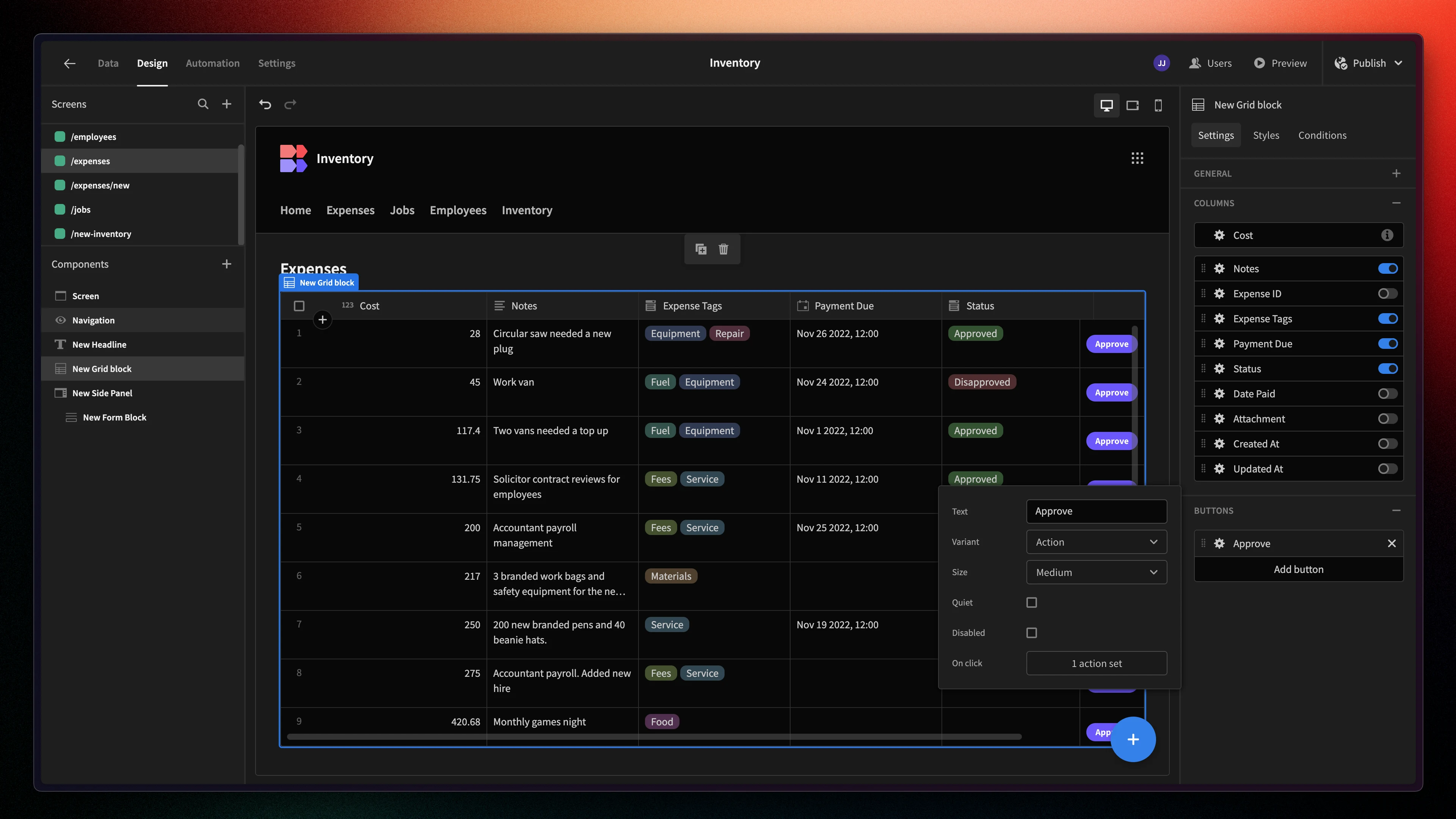
Features
Budibase is centered around fast, easy experiences for handling external data. We offer dedicated connectors for a huge range of SQL and NoSQL databases, Airtable, Google Sheets, REST APIs, and more. Combine our powerful database views and visual RBAC editor to create secure apps on top of any data.
We also have a built-in low-code database with full support for CSV uploads - along with dedicated CLI tools for building custom data sources.
Our interface builder combines the ease and speed of a drag-and-drop UI with the power and flexibility of optional custom code. Add JavaScript or use our library of handlebars helpers to manipulate data within your application front-end.
You can even build your own custom components or import community contributions - for added extensibility.
Budibase is also ideally suited to eliminating menial tasks through automation. We offer a flowchart-based editor for combining, configuring, and managing a library of built-in triggers and actions. You can even utilize branching or looping logic to automate end-to-end processes in a single flow.
Our platform also integrates with a wide range of external tools, using WebHooks, Zapier, REST APIs, custom AI configs, and more. We even offer our own platform API, along with free external SSO.
Use cases
Budibase is aimed at busy IT teams that need to output workflow applications at pace. Solutions architects, support engineers, data specialists, product owners, project managers, and more choose our platform to build incredible internal tools in a fraction of the time.
It’s the ideal tool for building forms, approvals apps, portals, admin panels, dashboards, directories, and much more.
Best of all, Budibase empowers teams to build custom low-code solutions on top of just about any kind of existing data.
We even offer auto-generated CRUD UIs, a library of customizable templates, powerful design tools, and optional custom code across our platform.
Pricing
Budibase bills on a per-user basis - but we distinguish between the colleagues who create apps and the ones who use them. Build as many apps as you want in our free tier for five users in the cloud or twenty users, if you self-host.
We even offer free SSO across all plans.
Premium licenses cost $50 per creator per month and $5 for end users - giving a highly cost-effective way to scale your usage as your needs grow and change.
We also offer custom pricing for enterprises, with enhanced security controls, audit logging, air-gapped deployments, and more.
2. Retool
Retool is one of the biggest names in the low-code space. Like Budibase, it’s aimed at improving the way teams output custom internal tools. However, the difference is that Retool is optimized for professional developers, rather than other IT colleagues.
As such, it offers extensive customization options - but does so at the expense of usability for less technical users, potentially including most typical Appian users.

Pros
A huge part of Retool’s popularity can be explained by its intuitive, flexible user interface. It provides a clean, accessible drag-and-drop interface for arranging, styling, and configuring a large range of built-in UI components.
Retool is also a strong offering for workflow automation, although it lacks some of the more advanced capabilities of Appian in this regard. Its flow-based editor offers branching logic and extensive scope for custom scripting.
There’s an extensive range of native database connectors, making Retool an attractive option for businesses that need to build internal tools based on a variety of internal data assets.
Cons
As an Appian alternative, Retool’s big downside is the relatively high technical skills barrier. Since it’s a developer-focused tool, we’re more likely to need to use custom code in any given use case.
Retool is also a relatively expensive option, which place it outside the reach of teams who want to experiment with low-code for the first time.
Lastly, it has suffered reputational problems in terms of security after a large-scale data breach in 2023. This is potentially problematic for a tool that’s intended to work with mission-critical production databases.
Pricing
Retool is billed on a four-tier model - Free, Team, Business, and Enterprise. Like Budibase, it also distinguishes between developers and end-users within its pricing.
However, each tier also imposes other usage-based limitations. For example, each of the standard paid tiers places restrictions on the number of automation runs we can have per month, which has the potential to push us to a more expensive license.
SSO and custom branding are restricted to the Enterprise tier, with custom pricing.
3. OutSystems
OutSystems is another Appian alternative that mainly targets developers. So, we have some of the most powerful capabilities around customization and extensibility - although it may be beyond the skills of less technical users.
It’s also highly enterprise-centric. As such, it offers a range of tools for larger development teams, including for testing, monitoring, user management, and other related tasks.
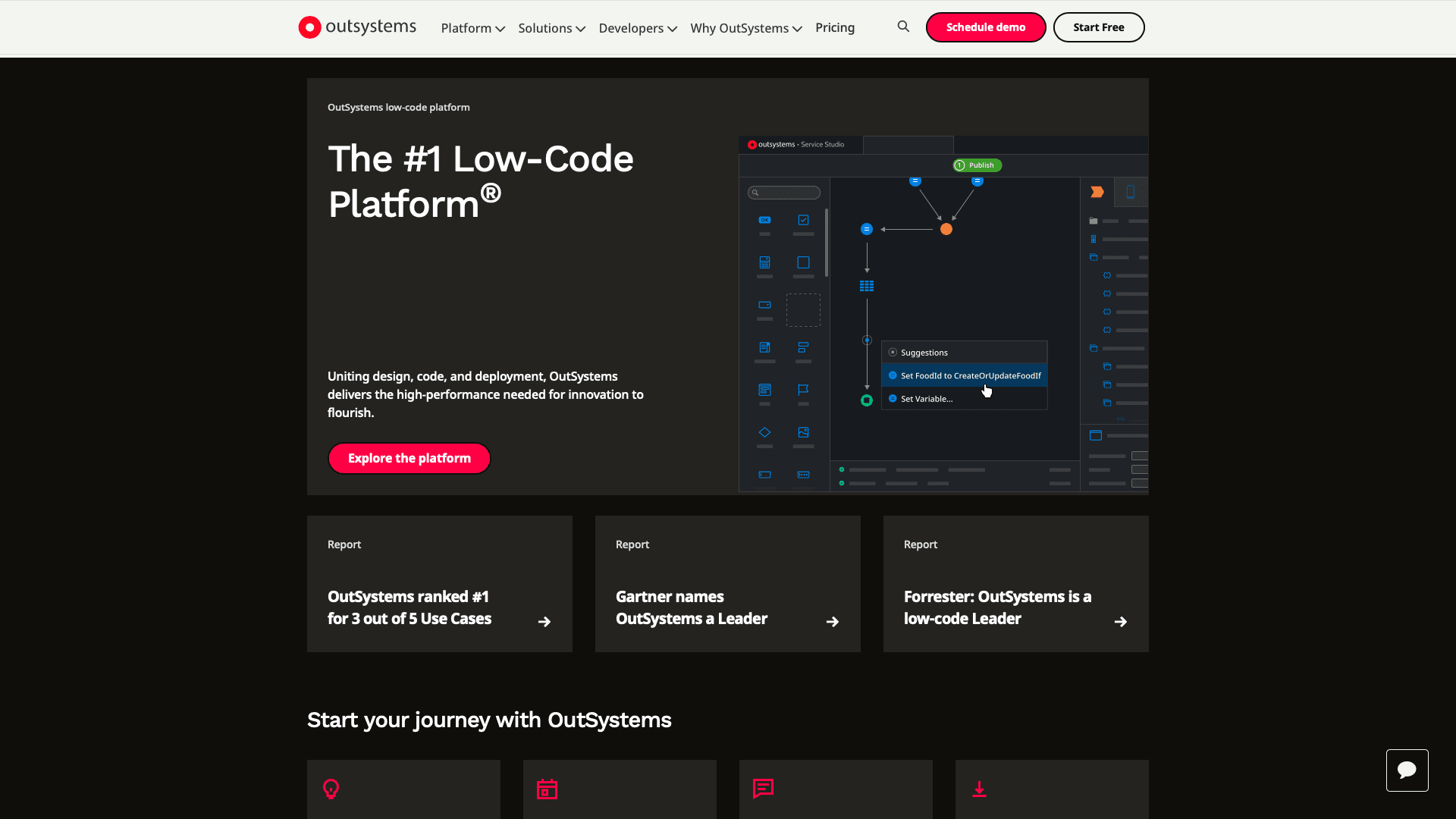
Pros
OutSystems really shines on extensibility. It offers support for external code libraries, frameworks, and SDKs. If you have the development skills, the possibilities are huge. It also offers an extensive marketplace for community contributions.
There are also features aimed at providing more advanced developer experiences - more in line with traditional SDLCs. For instance, version control, modular code, and flows for multi-platform development.
More recently OutSystems has launched a suite of tools leveraging generative AI for writing, testing, and monitoring code. Although, it’s still best if you have the development experience to know how the code in your applications actually works.
Cons
The big downside here is usability. Put simply, OutSystems will be too complex for the vast majority of non-developers. Even for experienced coders, there’s a steep learning curve, so it’s not ideal for everyone.
OutSystems is available as a self-hosted or cloud-based solution. However, installation flows for self-hosting are more complex than many other options. The cloud platform also imposes additional limitations and feature restrictions.
As we’ll see in a second, pricing is not exactly transparent - which can make it difficult to predict costs as we scale.
Pricing
Unlike most other Appian alternatives, OutSystems bills on a per-application basis. We can build a single application in a testing environment for free. Beyond this, we’ll need to pay a flat fee of $1,513 per month, plus additional costs.
OutSystems uses a concept called Application Objects (AOs) to bill based on usage. This includes things like data connections, automation runs, and other basic building blocks of your applications.
Custom enterprise pricing is also required for self-hosting or external SSO.
4. PowerApps
PowerApps is Microsoft’s offering in the low-code market. It’s also one of the oldest and most ubiquitous tools in this space. As you might expect, it’s particularly popular with businesses that are already heavily embedded in the Microsoft ecosystem.
However, it also presents limitations compared to some of the other Appian alternatives on the market today.
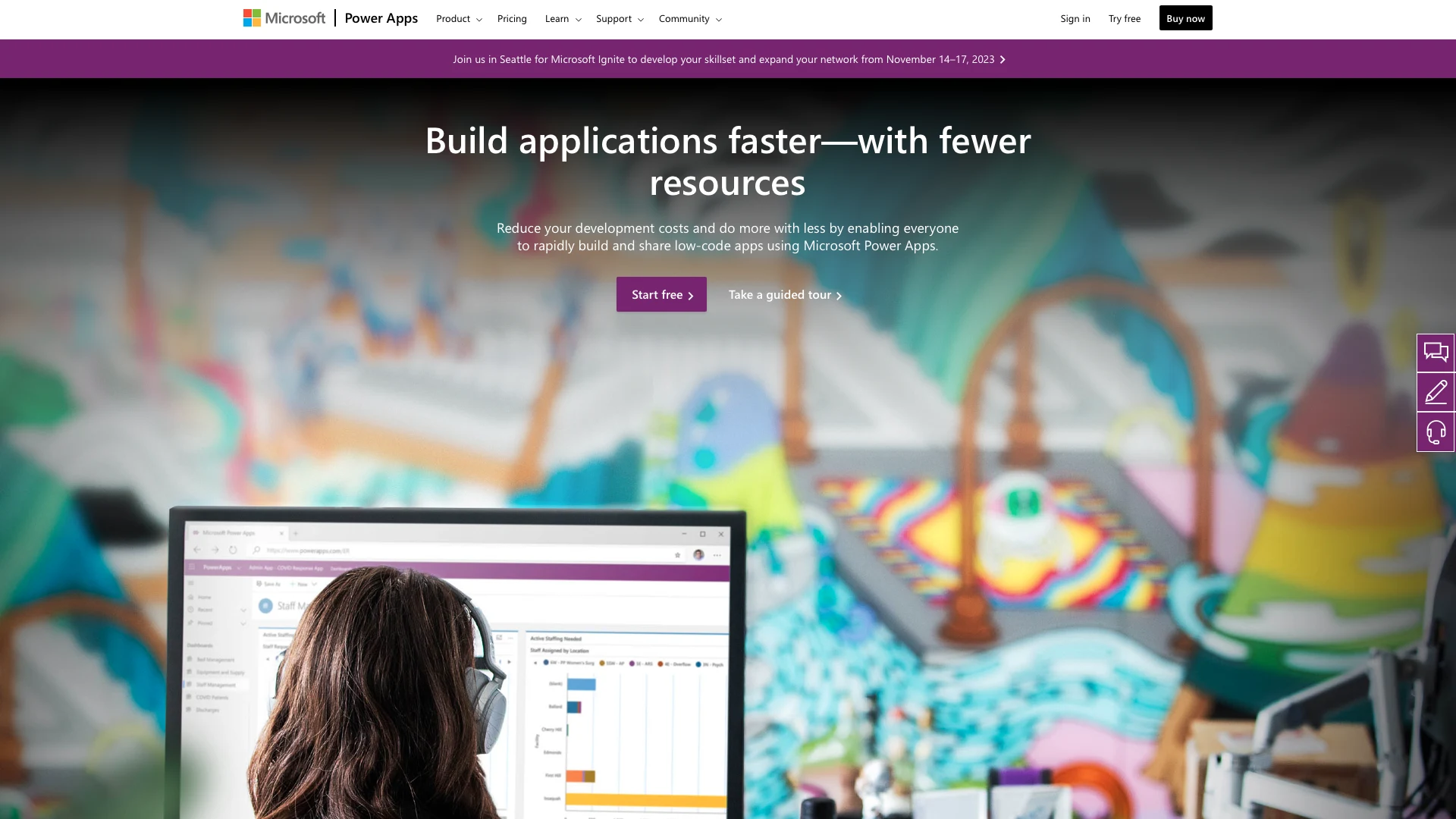
Pros
Microsoft go to great lengths to make it easy to get up and running with PowerApps. There’s a huge range of templates and sample applications to help get you started with all sorts of common use cases.
Front-end data manipulation is performed using Power Fx - which is a bit like a suped-up version of traditional spreadsheet formulae, providing an accessible experience for most business-level users.
PowerApps also offers close integration with other Microsoft platforms, including the dataverse, SQL Server, Dynamics, PowerBI, Office, and more.
Cons
PowerApps is not always well-regarded for usability. In fact, it presents a particularly steep learning curve compared to more modern Appian alternatives like Budibase or Retool.
Although Power Fx is intuitive in one way - it’s also very syntactically strict. On top of this, error messaging isn’t always very precise or specific. So, it can be hard to figure out why something isn’t working.
Lastly, PowerApps requires us to use other Microsoft platforms to access certain functionality. Automations are built in Power Automate, which is billed separately - while connecting to external databases is most easily done via the Dataverse.
Pricing
PowerApps offers one of the simplest pricing models in the low-code space. All users are billed at $20 per month, with no distinction between colleagues who create solutions vs end users.
However, there are other service limitations. For example, with regard to the data we can connect via the Dataverse.
We’d also be billed separately if we wanted to use related tools like Power Automate or AI Builder.
5. Mendix
Lastly, we have Mendix. Again, this is one of the older players in the space. It’s a developer-focused platform that’s built for teams in large enterprises.
So, there’s a range of capabilities targeted at these kinds of teams. At the same time, experiences may not be particularly well optimized for other kinds of users - especially smaller teams or less technical colleagues.
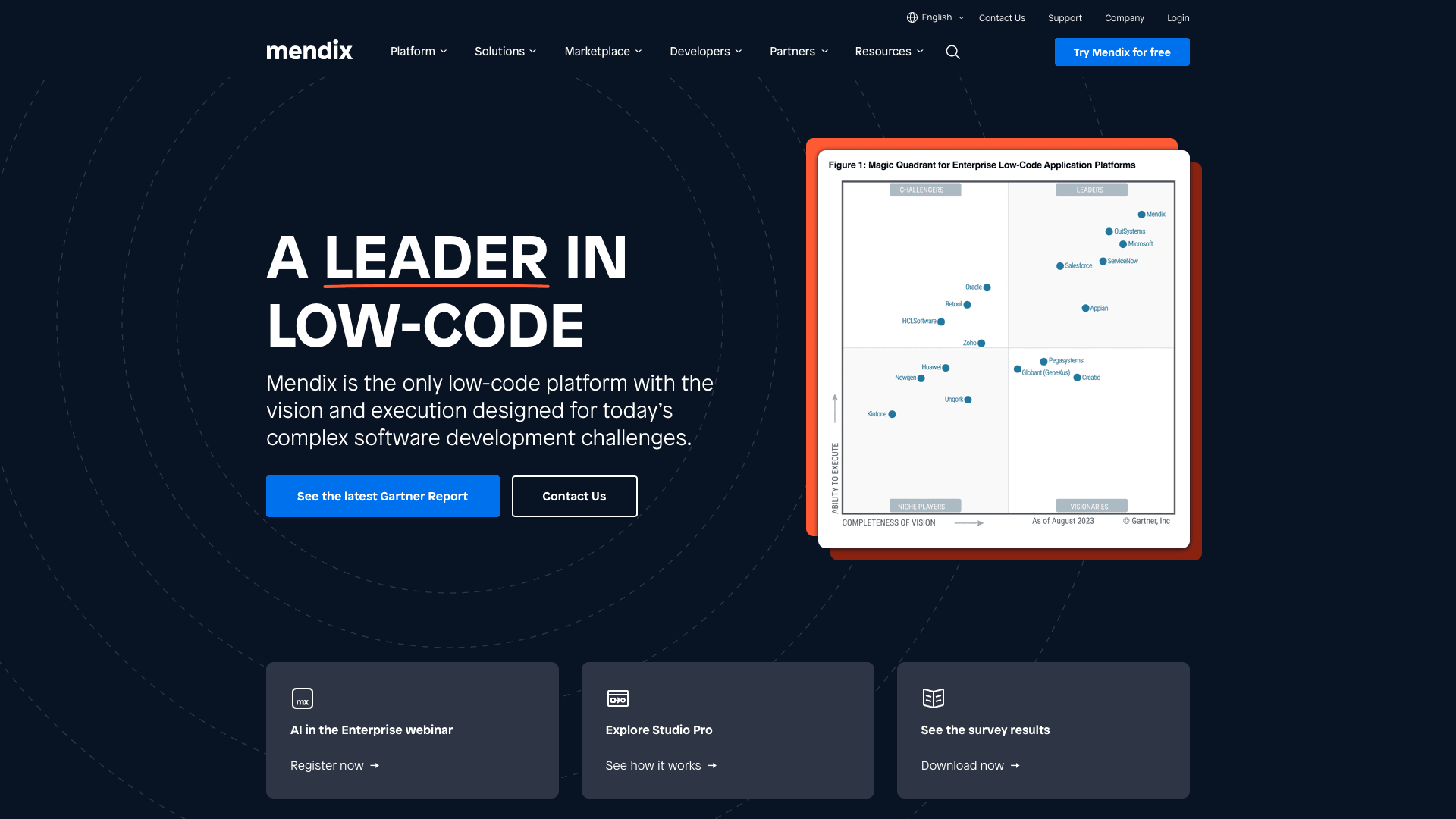
Pros
Mendix offers extensive capabilities for specialist development teams. It’s built around a visual IDE, with built-in version control, testing functionality, substantive code editing, and generative AI tools.
Extensibility is another big selling point. Mendix is one of the few Appian alternatives that offers a dedicated SDK. Users can build their own extensions, reusable modules, components, and other functionality.
Mendix also benefits from a large, active developer community. So, there’s a wealth of resources out there, including tutorials, tips, community contributions, and more.
Cons
However, Mendix is also one of the most inaccessible platforms on the market in terms of usability for non-technical colleagues. In fact, we’ll need some coding skills for most projects and use cases.
One key example of this is design customization. We need to use custom CSS for anything but the most basic design tasks, whereas most competitors offer much more native customization.
Many users also complain that Mendix’s UI is comparatively dated more generally.
Pricing
Mendix is one of the pricier low-code platforms out there. It offers different licensing structures depending on whether you want to build multiple applications or just one.
For multi-app licenses, there are three tiers - Free, Standard, and Premium. The free tier includes unlimited apps and users but limits us to a proprietary environment.
Paid multi-app licenses start from $2,000 per month for five users - plus additional per-user fees.
6. Filemaker
Next, we have Filemaker. Launched way back in the 1980s, this is Apple’s offering in the low-code market. As such, it’s one of the oldest names in this space.
In this time, it’s acquired a huge user base of teams in large organizations that need to centralize and de-silo data, as well as outputting working tools for interacting with this.

Pros
Filemaker offers a visual interface for defining schemas and creating databases - without needing to manually write custom queries. This opens up a huge amount of power and flexibility for users who might not have the skills to work with a traditional RDBMS.
On top of this, there’s a range of tools for designing interfaces, automating data workflows, and managing access to our data sets.
Another unique selling point of Filemaker is the ease with which we can output working solutions for a range of platforms. In particular, it offers a direct integration with Apple’s iOS SDK - so we can easily ship iPhone and iPad apps with minimal custom code.
Cons
However, there are certain areas where Filemaker falls down compared to our other Appian alternatives. One issue is that Filemaker databases are stored in a proprietary format, which can make migrating them to a traditional DBMS slightly more difficult.
Another common complaint with Filemaker users is that the development experience feels a little bit dated compared to some of the more modern platforms on the market - although this is equally a common criticism of Appian too.
External data support is a somewhat mixed affair compared to other platforms in this class. For instance, we can’t directly query NoSQL tools using a native connector - instead, having to rely on custom API requests.
Pricing
Filemaker is also one of the pricier platforms on the market. There’s no free version available, although, novelly, we can buy lifetime single-user licenses.
The Essentials tier bills at $21 per user per month for 5-10 users and up to three applications. The Standard tier ($43) expands this to up to 99 users and 125 applications. As such, pricing is particularly prohibitive for smaller teams and use cases.
On top of this, there are usage-based limits across the tiers relating to stored data, computing resources, and API requests - making the cost of scaling slightly harder to predict.
7. Zoho Creator
Creator is Zoho’s offering in the low-code market. It’s a particularly strong option for IT teams that want to empower non-developers and other on-the-ground colleagues to build solutions for their own needs - without sacrificing control and governance.
It’s also a popular platform by virtue of the power and flexibility that it offers for custom internal tools development.
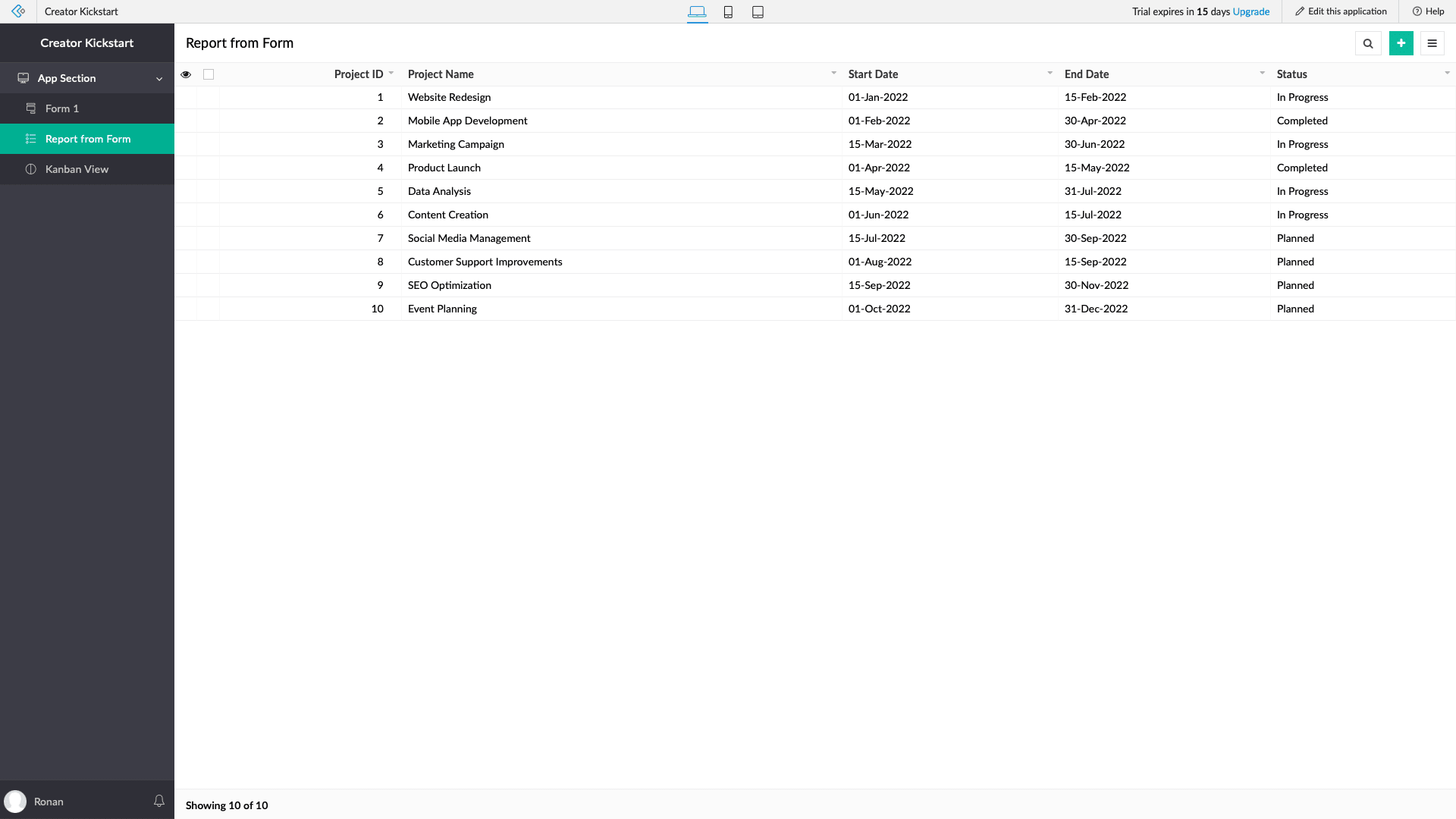
Pros
As part of the Zoho ecosystem, Creator is particularly strong when it comes to integration with your existing tool stack. In particular, it offers a huge range of native integration options for external SaaS tools, CRMs, data management solutions, and more.
There’s also huge scope for customization. Front-end scripting is performed using the proprietary Deluge language. This is a relatively forgiving, easy to learn scripting language, offering a great deal of flexibility to users with minimal existing coding skills.
For IT teams, Creator really shines in terms of retaining control and governance over how colleagues interact with data assets.
Cons
However, there are some big downsides to Zoho Creator too. Proprietary scripting languages are always a double-edged sword. They might be easier for non-developers to learn - but this is counteracted by the fact that users with coding skills can’t use a language they already know.
Some users also complain that Creator doesn’t quite strike the perfect balance between usability and capabilities. Indeed, some users complain that it presents a steep learning curve for non-technical colleagues - while also lacking the power and flexibility of other tools.
Creator can be self-hosted, which is a huge benefit to many businesses. However, teams that deploy the platform to their own infrastructure won’t enjoy the full complement of features that are available in the cloud platform
Pricing
Zoho’s pricing model positions Creator as one of the most cost-effective solutions in the low-code market. There are three monthly per-user tiers - Standard ($8), Professional ($20), and Enterprise ($25).
However, we’ll need a Professional license or above to build multiple applications. There are also usage-based restrictions across the tiers in terms of automation runs and connected data.
One aspect that’s unique to Zoho’s pricing is that certain enterprise features, such as SSO, are available as optional extras at any price point.
8. Caspio
Lastly, we have Caspio. Launched in 2000, this is a very direct competitor to Appian. It’s highly targeted towards teams in large enterprises that need to output large volumes of web apps at pace.
As low-code platforms go, it skews more heavily toward the technical users - and even experienced developers.

Pros
One particularly interesting part of Caspio’s offering is its internal database. This is actually based on SQL Server. Like most tools, we can use a visual interface to create and manage databases, but we can also write SQL queries directly within the platform.
As a large, well-established player in the space, Caspio has a strong track record in terms of security and reliability - as well as an active community of users and a wealth of resources.
It also offers a wide range of configurable charts, table UIs, reporting tools, and more, making it easy to create effective data-centric applications with little to no custom code.
Cons
Compared to some of the more modern Appian alternatives we’ve seen, there are some areas where Caspio really shows its age. In particular, developer experiences feel a bit dated relative to other tools that place a greater emphasis on UX.
It’s also somewhat lacking in terms of automation capabilities. We can schedule basic database actions and other tasks using basic if/then conditions, but this falls short of what’s possible in some other platforms, including Appian.
Caspio is also more focused on building tools around internally stored data, so it doesn’t offer as extensive support for external data sources as we might expect from other low-code tools.
Pricing
Caspio is also one of the only platforms in its class that doesn’t bill on a per-user basis. Instead, there are several tiers of fixed licenses for unlimited users. As such, it has the potential to be very cost-effective for larger user bases.
There are four tiers - Free, Starter ($50), Professional ($600), and Enterprise ($2,250). Each of these comes with usage-based limitations based on stored records and DataPages - a proprietary concept that essentially equates to a UI for interacting with data.
Additionally, there are feature limitations across the different price points. For instance, we’ll need an Enterprise license to access single sign-on.
Appian vs Budibase
Now that we’ve seen a range of options from across the low-code market, it’s time to dive deeper into how Budibase and Appian stack up against each other.
Both platforms seek to provide teams with a faster, easier way to output internal tools.
But equally, they take a slightly different approach to achieving this. Appian largely targets business-level users whereas Budibase is optimized for non-developers within IT teams.
Here’s how they compare.
Data
Appian offers a built-in database alongside support for external relational databases and API connections. This makes it a relatively attractive option for creating workflow applications and automations based on existing business data.
However, only relational databases in certain hosts are supported and we’ll need to install the appropriate drivers ourselves.
Budibase provides vastly superior experiences for handling external data.
We offer dedicated connectors for a range of SQL and NoSQL databases, as well as Airtable, Google Sheets, REST APIs, and more. We also have a built-in low-code database and a dedicated CLI for building your own data sources.
We even offer a spreadsheet-like interface for performing CRUD operations on supported data sources, either in Budibase’s back end or as a user-facing UI component. You can easily create role-specific database views for performing controlled CRUD actions or viewing calculations and aggregations. UIs that we generate based on these will inherit access policies from the underlying data source.
UIs
Appian’s UI builder offers a wide range of configurable components - as well as generative AI tools to build custom interfaces for a range of use cases. However, the builder itself feels a little dated and lacks scope for adding custom code.
Budibase is the fast, flexible way to build all kinds of workflow applications.
Our drag-and-drop UI builder makes coding completely optional. Add front-end logic and data manipulations using JavaScript or our library of built-in handlebars helpers.
We also offer autogenerated CRUD screens and forms, custom conditionality rules, mobile responsiveness, in-app theming, and more.
Customization
Appian offers an SDK for building custom extensions, as well as a range of proprietary plug-ins that are accessible via the Appian Suite API.
At the same time, there’s a disconnect between this kind of extensibility and Appian’s target user persona. That is, building extensions via their SDK would require relatively high development skills for a platform aimed at business-level users.
Budibase offers dedicated CLI tools for building custom components and data sources.
Or, you can import community contributions from our plug-ins repo and start leveraging existing extensions across your low-code development projects. We also offer custom AI configs, enabling you to power key Budibase AI features with the LLM of your choice.
Management, administration, and hosting
Appian is available as either a self-hosted solution or a cloud-based platform. However, users with free licenses are limited to the cloud offering. However, some users complain that self-hosted releases do not keep pace with the cloud offering.
Self-hosted installations also require a relatively high amount of configuration compared to some alternatives.
In terms of user limits, Appian distinguishes between Standard, Infrequent, and Input-Only users. This means that there’s no distinction between app creators and end-users in terms of pricing.
Budibase’s cloud and self-hosted versions have significantly more feature parity. We also offer fast, easy installation for self-hosted licenses using Kubernetes, Docker, Digital Ocean, Portainer, Podman, and more.
Our pricing model distinguishes between creators and end-users for easy scalability. We even offer free SSO across all pricing tiers.
How to choose an Appian alternative
Lastly, it’s important to reemphasise that each platform in the low-code space targets distinct user personas and organizations. Therefore, we need to be realistic that no single platform can be fully optimized for every use case.
Instead, we need a framework for deciding which of the platforms we’ve seen today is right for us.
Here are the key decision points you’ll want to consider.
Pricing
On paper, pricing seems like it should be a relatively simple variable to assess. But, in reality, it can be very difficult to compare like-with-like.
Almost every platform we’ve seen bills on a per-user basis.
However, there’s a lot of variation within this - including whether or not vendors distinguish between different types of users, as well as how different feature restrictions and usage limits are imposed across pricing tiers.
Therefore, one platform might be high cost-effective in certain situations, but excessively costly in others.
Here’s an example scenario of what each of the Appian alternatives we’ve seen will cost for different user and app volumes, assuming we need unlimited automations and for all of our users to access the platform at least once per week.
 Appian* |  Budibase |  Retool |  Mendix |  Outsystems** |  PowerApps |  Filemaker |  Zoho Creator | Caspio*** | |
|---|---|---|---|---|---|---|---|---|---|
| 2 creators + 50 users | $3,900 | $350 | $680 | $3,175 | $1,513+ | $1,040 | $2,236 | $1,040 | $600 |
| 3 creators + 100 users | $7,725 | $650 | $1,320 | $4,450 | Custom | $2,060 | $4,429 | $2,060 | $600 |
| 5 creators + 200 users | $15,375 | $1,250 | $2,500 | $7,000 | Custom | $4,100 | $8,815 | $4,100 | $600 |
| 6 creators + 1000 users | $75,450 | $5,300 | $12,140 | $27,025 | Custom | $20,120 | $43,258 | $20,120 | $600 |
**Appian provides a $66 discount for any user who accesses an application less than four times in a given month, so licensing costs may be considerably lower for infrequent usage.
***Based on the Professional tier, offering equivalent access to automations and integrations compared to other platforms.
*Appian provides a $66 discount for any user who accesses an application less than four times in a given month, so licensing costs may be considerably lower for infrequent usage.
**OutSystems impose limits on Application Objects, which must be purchased on top of stated license fees. The number of these required to build a particular use case is unpredictable.
Scalability
Scalability is how easily we can expand our usage of a given platform - including how costs will increase as our needs grow and change.
There are two elements to this. The first is pricing. The second is each platforms actual ability to accommodate increased usage from a technical point of view.
On the pricing front, the issue stems from the fact that various platforms impose distinct usage limits and feature restrictions across their license tiers.
On the technical front, we’re dealing with issues like performance, external data support, and functionality for dealing with larger use cases - including things like SSO or audit logging.
The important thing is to factor in how these will impace our long-term usage of any given platform.
Open-source vs closed-source
Open-source technology is a top priority for many businesses - especially enterprises and other large organizations.
For these kinds of companies, it’s important to be able to audit the source ode of any platforms that will interact with production data, internal infrastructure, or mission-critical processes.
Closed-source technologies might require additional mitigations and policies, creating extra costs.
Here’s a breakdown of how the Appian alternatives we’ve seen today sit in this regard.
 Appian |  Budibase |  Retool |  Mendix |  Outsystems |  PowerApps |  Filemaker |  Zoho Creator | Caspio | |
|---|---|---|---|---|---|---|---|---|---|
| Open-source vs Closed-source | Closed-source | Open-source | Closed-source | Closed-source | Closed-source | Closed-source | Closed-source | Closed-source | Closed-source |
Builder personas
We’ve seen extensively that vendors in the low-code space are aimed at different kinds of users - especially with regard to their level of technical skills and expertise.
Some platforms like Appian are largely aimed at business-level users. Others, like OutSystems, are full-on developer tools.
In between, we have a range of options that empower users of varying technical abilities to handle data, manage processes, and output internal tools.
Here’s one way of breaking down the platforms we’ve seen today.
 Appian |  Budibase |  Retool |  Mendix |  Outsystems |  PowerApps |  Filemaker |  Zoho Creator | Caspio | |
|---|---|---|---|---|---|---|---|---|---|
| Technical level - Target users | Medium - IT teams | Medium - IT teams | High - Engineers | High - Engineers | High - Engineers | Medium - IT teams | Medium - IT teams | Medium - IT teams | Medium - IT teams |
Extensibility
Lastly, extensibility is the degree to which we can add new capabilities to a platform. This can either mean building additional elements ourselves or integrating with other existing tools to add functionality.
There are some aspects to this that most platforms have in common - like connecting to external platforms via API requests.
However, some platforms take extensibility much further than others. For instance, some of the tools that we’ve seen offer dedicated SDKs, some leverage custom plug-ins, and others offer little scope to add additional functionality.
Here’s a summary of what each of our Appian alternatives offers.
 Appian |  Budibase |  Retool |  Mendix |  Outsystems |  PowerApps |  Filemaker |  Zoho Creator | Caspio | |
|---|---|---|---|---|---|---|---|---|---|
| Custom Components | |||||||||
| Custom Data Sources | |||||||||
| REST API connector | |||||||||
| AI integrations | |||||||||
| Webhooks | Priced separately | ||||||||
| Security certs | ISO27001 SOC 2 | ISO27001 | SOC 2 | ISO27001 SOC 2 | ISO27001 SOC 2 | ISO27001 SOC 2 | ISO27001 SOC 2 | ISO27001 SOC 2 | ISO27001 SOC 2 |
| Public API | Under Alpha | ||||||||
| OIDC Auth support | Enterprise plan | Free plan | Enterprise plan | Enterprise plan | Enterprise plan | Enterprise plan | Paid plans | Optional add-on | Enterprise plan |
| Self-hosting |